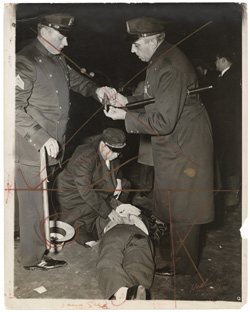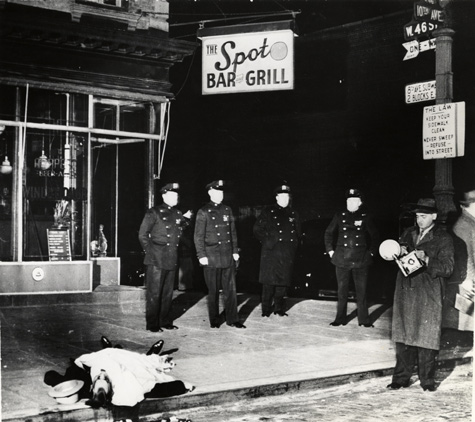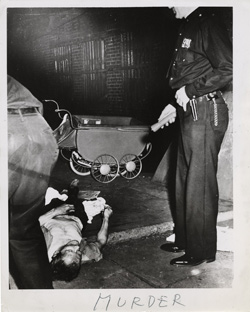
Now you know that no one wakes up at 9 o’clock at night unless he’s looking for trouble. And this character is definitely looking for trouble. So, how long before he finds it? Not long at all.
“I arrive right in the heart of Little Italy, 10 Prince Street, here’s a guy had been bumped off in the doorway of a little candy store…”
Bingo! Here’s trouble.
Now what?
We throw in a twist; that’s what.
“There was another photographer there and he made what they call a ten-foot shot—he made a shot of just the guy laying in the doorway, that was it.”
Another photographer?
That’s right. Keep up, wouldja?
“To me this was drama; this was like a backdrop. I stepped all the way back about a hundred feet. I used flash powder and I got this whole scene: the people on the fire escapes; the body; everything. Of course the title for it was ‘Balcony Seats at a Murder.’ That picture won me a gold medal with a real, genuine diamond.”
(Say it with me: “gen-u-ine.”)
The character doing the talking here is no ordinary jamoke. This is Arthur Fellig, only you know him better as Weegee—or Weegee the Famous—and murder is (or was) his business.
When you’re talking about crime scene photography, the discussion begins and ends with Weegee, who prowled the night streets of New York City in the 1930s and 40s shooting anything—or at least anyone—that didn’t move.

“The easiest kind of job to cover was a murder because the stiff would be laying on the ground, he couldn’t get up and walk away or get temperamental, and he would be good for at least two hours so I had plenty of time,” Weegee explained.
(Weegee’s comments on the 1958 recording Famous Photographers Tell How are worth their weight in gen-u-ine diamonds. Click here to listen.)
Of course Weegee photographed live events too: fires and fights, arrests and perp walks… He was a master of his craft. A true artist. Only don’t call him an artist; that would just upset him. “Part of Weegee’s life crisis was when his work started to be considered as art and was shown at the Museum of Modern Art,” says Brian Wallis, curator of the new exhibition, “Weegee: Murder Is My Business,” at the International Center of Photography in New York through September 2. (The exhibit is culled from the 20,000 of Weegee’s photographs in ICP’s collection—the world’s largest archive of Weegee’s work.)

Weegee was choosy about what he photographed. Even a drunk in a gutter had to be aesthetically pleasing or Weegee would walk on by. And even though it’s said that he wasn’t above staging a shot—if, for example, a corpse wasn’t positioned in the most photogenic manner—he never lacked for material. The “Naked City” gave him everything he could ever need. It even provided the title for a 1945 book of his photographs that would go on to inspire the 1948 noir film of the same name.
His matter-of-fact attitude to the grim and grisly was a perfect example of the macabre humor that characterizes what fans love about noir. No one had better perspective on crime; his vision is now what we envision when we imagine the mean streets of 1930s New York. Like all the world’s great characters, there will never be another one quite like Weegee.
Images by Weegee © Weegee/International Center of Photography
Photo “Weegee on the Job” © International Center of Photography
Leslie Gilbert Elman, author of Weird But True: 200 Astounding, Outrageous, and Totally Off the Wall Facts, would like to remind you—subtly—that books make excellent gifts. Follow her on Twitter @leslieelman.

Even just one of those pix would be inspiration for all kinds of dark noir-ish stuff. I didn’t know there was a guy who took all those photographs–wow! And great nickname.
Great post!
Thank you @MFrampton and @JakeHinkson
Click on the link to the sound recording if you haven’t already. Weegee’s voice is outstanding. I read that Peter Sellers based one of his characters’ voices in Dr. Strangelove on Weegee.
This photo exhibit is supposed to travel after it closes in NYC in September. If I find out where and when, I’ll post info here.
I love Weegee’s photos, but I never knew that about his voice. As I listened to the clip, not only was it fascinating to hear his vocabulary and descriptions, but I realized (again) what a genius mimic Sellers was. So cool, Leslie!